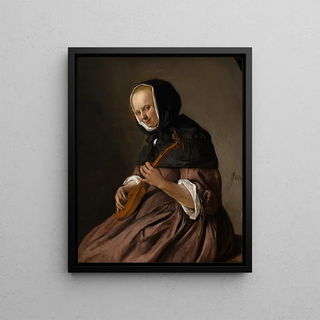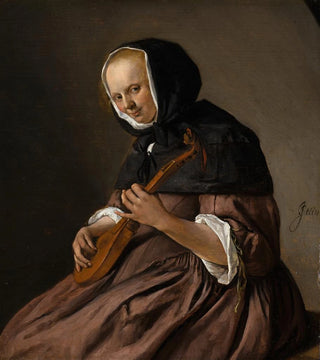Art print | Woman playing the cittern - Jan Steen


View from behind

Frame (optional)
Art print Femme jouant du cistre - Jan Steen – Captivating introduction
In the vast panorama of 17th-century Dutch art, the work "Femme jouant du cistre" by Jan Steen stands out for its liveliness and convivial atmosphere. This painting, which captures an intimate moment of everyday life, transports us to a universe where music and friendliness blend harmoniously. The artist, known for his skill in depicting genre scenes, manages to evoke deep emotions through simple gestures. The art print of this iconic work allows appreciation of the richness of details and the subtlety of colors that characterize Steen's style, while offering a window into an era where art and life intertwined.
Style and uniqueness of the work
Jan Steen's style is marked by a realistic and lively approach, where each character seems animated with a life of its own. In "Femme jouant du cistre," the protagonist, immersed in music, appears to capture the very essence of joy of living. The facial expressions, the play of lights and shadows, as well as the carefully orchestrated composition, testify to the artist's skill in creating a warm and engaging atmosphere. The richness of details, from clothing to everyday objects, reveals meticulous attention that invites the viewer to immerse themselves in this scene. Steen excels at depicting moments of shared happiness, and this work is a perfect example, where music becomes the guiding thread of authentic human interaction.
The artist and his influence
Jan Steen, born in 1626 in Leiden, is one of the masters of Dutch painting of the 17th century. His work, often imbued with humor and satire, reflects daily life of his time while raising moral and social questions. Steen draws inspiration from his contemporaries, such as Vermeer and Rembrandt, but develops a style that is uniquely his own, marked by vibrant genre scenes and dynamic compositions. His influence endures through the centuries, inspiring many artists and continuing to captivate audiences. By depicting moments of everyday life with such finesse, he contributed to establishing a new way of approaching art, where the banal becomes sublime.

Matte finish

View from behind

Frame (optional)
Art print Femme jouant du cistre - Jan Steen – Captivating introduction
In the vast panorama of 17th-century Dutch art, the work "Femme jouant du cistre" by Jan Steen stands out for its liveliness and convivial atmosphere. This painting, which captures an intimate moment of everyday life, transports us to a universe where music and friendliness blend harmoniously. The artist, known for his skill in depicting genre scenes, manages to evoke deep emotions through simple gestures. The art print of this iconic work allows appreciation of the richness of details and the subtlety of colors that characterize Steen's style, while offering a window into an era where art and life intertwined.
Style and uniqueness of the work
Jan Steen's style is marked by a realistic and lively approach, where each character seems animated with a life of its own. In "Femme jouant du cistre," the protagonist, immersed in music, appears to capture the very essence of joy of living. The facial expressions, the play of lights and shadows, as well as the carefully orchestrated composition, testify to the artist's skill in creating a warm and engaging atmosphere. The richness of details, from clothing to everyday objects, reveals meticulous attention that invites the viewer to immerse themselves in this scene. Steen excels at depicting moments of shared happiness, and this work is a perfect example, where music becomes the guiding thread of authentic human interaction.
The artist and his influence
Jan Steen, born in 1626 in Leiden, is one of the masters of Dutch painting of the 17th century. His work, often imbued with humor and satire, reflects daily life of his time while raising moral and social questions. Steen draws inspiration from his contemporaries, such as Vermeer and Rembrandt, but develops a style that is uniquely his own, marked by vibrant genre scenes and dynamic compositions. His influence endures through the centuries, inspiring many artists and continuing to captivate audiences. By depicting moments of everyday life with such finesse, he contributed to establishing a new way of approaching art, where the banal becomes sublime.






